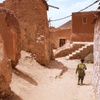Disclaimer
This entry contains information known to us from a variety of sources but may not include all the information currently available. Please be in touch if you notice any inadvertent mistakes in our presentation or have additional knowledge or sources to share. Thank you.
Archive
Mellah Entrance, Ighil, Morocco
Mellah Entrance, Ighil, Morocco
Description
Take a special tour through the mellah (Jewish quarter) of the village of Ighil’n'Ogho, in the southern Moroccan region of Tallouine. Raphy Elmaleh shows the former home of the village’s rabbi, who in an usual custom would keep the communal Torah scroll in his home rather than in the synagogue. Elmaleh introduces Zubeida, the haratine woman who today guards the town’s synagogue, which Elmaleh helped restore. He also chats with Zubeida’s brother, who worked on the restoration, and with an old man in the village who used to be the guardian of the mellah, making sure the Jewish quarter’s gate was locked at night. The man identifies individuals in old photographs from the village (seen at the beginning of the video) and points out the homes and stores of Jews who left 50 years ago.At the center of the drama in the village — once home to over 300 Jews — is the geniza (burial ground for old religious texts) located beneath the synagogue.
Muslim inhabitants of village recall that when the Jews left 50 years ago, they buried their books there and warned that no one should go inside; if anyone did they would be bitten by a scorpion and die. At the end of the video, Elmaleh reveals what happened the day he decided to risk his life to open the geniza. The result is a charming vignette that reflects the intricacies of Muslim-Jewish interaction in rural Morocco.
Ighil n'Ogho History: Ighil n’Ogho was the central mellah (an established Jewish quarter, named after the salt marsh area in Fez where the first mellah was created1) in the Talouine region (Zagmouzen tribe) in southern Morocco, dating back to the sixteenth century, possibly even earlier. It is estimated to have had around 350 inhabitants during the twentieth century, due to a 1936 census indicating 240 Jews living in the region, as well as the findings in the cemetery that is 1.2 miles away (see here). The Jews of Ighil n’Ogho held an array of occupations from jewelers to blacksmiths and cobblers to saddlers. The main languages they spoke were Judeo-Arabic and Berber. The centuries-old Jewish community fragmented, as the majority of the Jews migrated to Israel in 1963.2 There is a synagogue in the mellah that has been slowly decaying, but with the help of Fondation du Patrimoine culturel judéo-marocain and the caretaker, Zoubeida, it is being restored and watched over.3
Sources
[1] Emily Gottreich, “Mallāḥ,” in Encyclopedia of Jews in the Islamic World, ed. Norman A. Stillman, (Leiden, Netherlands: Brill), Accessed 20 July 2021.
[2] Yossef Chetrit, “Ighil n'Ogho,” in Encyclopedia of Jews in the Islamic World, ed. by Norman A. Stillman, (Leiden, Netherlands: Brill), Accessed 20 July 2021.
[3] Aomar Boum, "Sacred Protectors: Crossing Boundaries of Time and Faith, These Muslims Safeguard Morocco’s Holy Jewish Sites," Jewish Journal, Last modified January 10, 2018. https://jewishjournal.com/cover_story/229491/sacred-protectors-crossing-boundaries-time-faith-muslims-safeguard-moroccos-holy-jewish-sites/

![Ighil’n’Ogho Mellah [2] (Ighil’n’Ogho, Morocco, 2010)](https://cdn.filestackcontent.com/Y1PyV3KhRds4nNrR1vs8/convert?w=100&h=100&fit=crop)
![Ighil’n’Ogho Mellah [1] (Ighil’n’Ogho, Morocco, 2010)](https://cdn.filestackcontent.com/xxMrM0hQvax8ybWpU8EU/convert?w=100&h=100&fit=crop)





